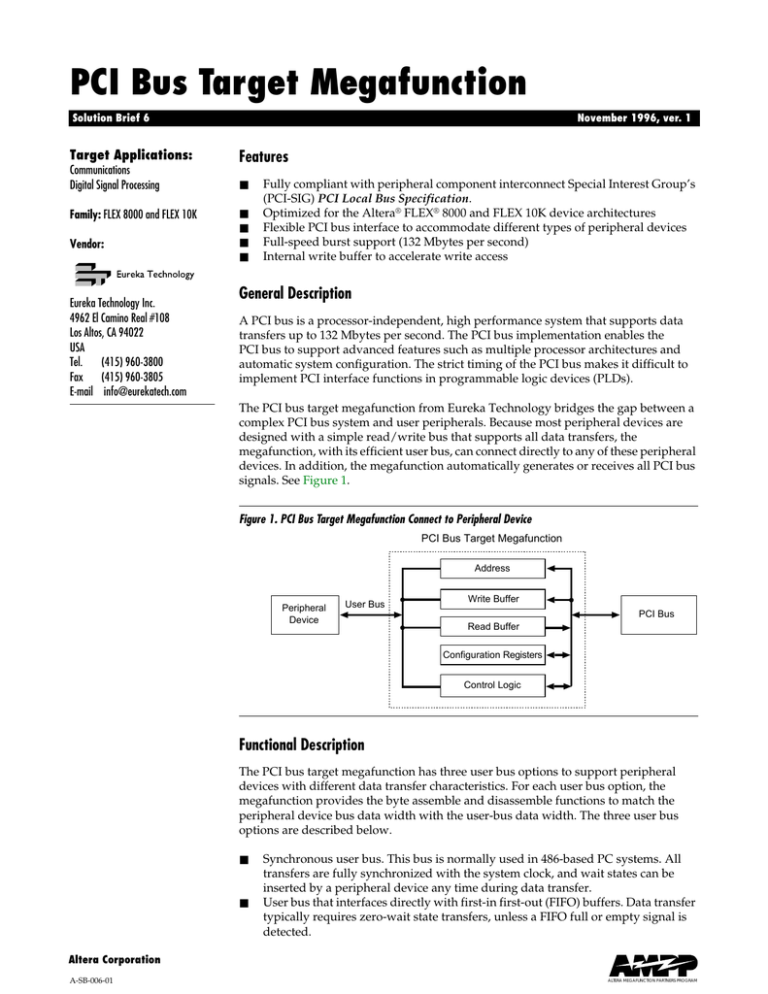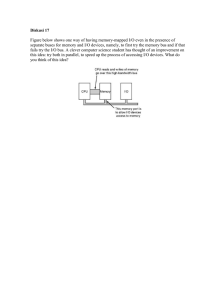
PCI Bus Target Megafunction
Solution Brief 6
Target Applications:
Communications
Digital Signal Processing
Family: FLEX 8000 and FLEX 10K
Vendor:
Eureka Technology Inc.
4962 El Camino Real #108
Los Altos, CA 94022
USA
Tel.
(415) 960-3800
Fax (415) 960-3805
E-mail info@eurekatech.com
November 1996, ver. 1
Features
■
■
■
■
■
Fully compliant with peripheral component interconnect Special Interest Group’s
(PCI-SIG) PCI Local Bus Specification.
Optimized for the Altera® FLEX® 8000 and FLEX 10K device architectures
Flexible PCI bus interface to accommodate different types of peripheral devices
Full-speed burst support (132 Mbytes per second)
Internal write buffer to accelerate write access
General Description
A PCI bus is a processor-independent, high performance system that supports data
transfers up to 132 Mbytes per second. The PCI bus implementation enables the
PCI bus to support advanced features such as multiple processor architectures and
automatic system configuration. The strict timing of the PCI bus makes it difficult to
implement PCI interface functions in programmable logic devices (PLDs).
The PCI bus target megafunction from Eureka Technology bridges the gap between a
complex PCI bus system and user peripherals. Because most peripheral devices are
designed with a simple read/write bus that supports all data transfers, the
megafunction, with its efficient user bus, can connect directly to any of these peripheral
devices. In addition, the megafunction automatically generates or receives all PCI bus
signals. See Figure 1.
Figure 1. PCI Bus Target Megafunction Connect to Peripheral Device
PCI Bus Target Megafunction
Address
Peripheral
Device
User Bus
Write Buffer
PCI Bus
Read Buffer
Configuration Registers
Control Logic
Functional Description
The PCI bus target megafunction has three user bus options to support peripheral
devices with different data transfer characteristics. For each user bus option, the
megafunction provides the byte assemble and disassemble functions to match the
peripheral device bus data width with the user-bus data width. The three user bus
options are described below.
■
■
Synchronous user bus. This bus is normally used in 486-based PC systems. All
transfers are fully synchronized with the system clock, and wait states can be
inserted by a peripheral device any time during data transfer.
User bus that interfaces directly with first-in first-out (FIFO) buffers. Data transfer
typically requires zero-wait state transfers, unless a FIFO full or empty signal is
detected.
Altera Corporation
A-SB-006-01
ALTERA MEGAFUNCTION
MEGAFUNCTION PARTNERS
ALTERA
PARTNERS PROGRAM
PROGRAM
SB 6: PCI Bus Target Megafunction
■
User bus that is similar to the industry-standard architecture (ISA) bus design.
Data transfer is not required to synchronize with the system clock. In this mode,
buses narrower than 32 bits are allowed.
The megafunction also includes a 32-bit write buffer that improves the speed of write
operations on a user bus. As data is written into the megafunction’s write buffer, the
data transfer on a bus is completed simultaneously, allowing the bus to perform other
write operations. The peripheral device may take as many clock cycles as needed to
complete the write operation without affecting the bus performance.
The PCI bus specification requires all target devices to support several configuration
registers, which are used by the system software for automatic system configuration.
Special configurations, however, are required for the system to access the registers. The
megafunction contains all configuration registers, and it automatically handles all
configuration cycles without requiring the peripheral device to process them.
Table 1 lists the required configuration parameters.
Table 1. Configurable System Parameters
Configuration Parameter
Device ID
Size
16 bits
Assigned By
User
Vendor ID
16 bits
PCI-SIG
Class code
24 bits
User
Revision ID
8 bits
User
Address range
–
User
Subsystem ID
16 bits
User
Subsystem vendor ID
16 bits
PCI-SIG
Performance
The PCI bus allows a high bandwidth data transfer. The megafunction supports burst
data transfer up to 132 Mbytes per second. Once initiated, zero-wait state data transfer
can be sustained between a peripheral device and a PCI bus. If slower peripheral
devices are used, wait states must be inserted to accommodate slower peripheral
performance. Table 2 illustrates the device utilization for a typical PCI bus
implementation.
Table 2. Typical Device Utilization
Function
User Bus Option
Logic Cells
PCI bus target with burst mode
Synchronous bus
340
PCI bus target without burst mode
Synchronous bus
250
Reference
PCI Local Bus Specification. Rev. 2.1. Portland, Oregon: PCI Special Interest
Group, 1995.
®
2610 Orchard Parkway
San Jose, CA 95134-2020
(408) 894-7000
http://www.altera.com
2
Copyright 1996 Altera Corporation. Altera, AMPP, FLEX, FLEX 8000, and FLEX 10K are trademarks and/or service marks of Altera
Corporation in the United States and other countries. Other brands or products are trademarks of their respective holders. The specifications
contained herein are subject to change without notice. Altera assumes no responsibility or liability arising out of the application or use of any
information, product, or service described herein except as expressly agreed to in writing by Altera Corporation. Altera customers are advised
to obtain the latest version of device specifications before relying on any published information and before placing orders for products or
services. All rights reserved.
Altera Corporation





